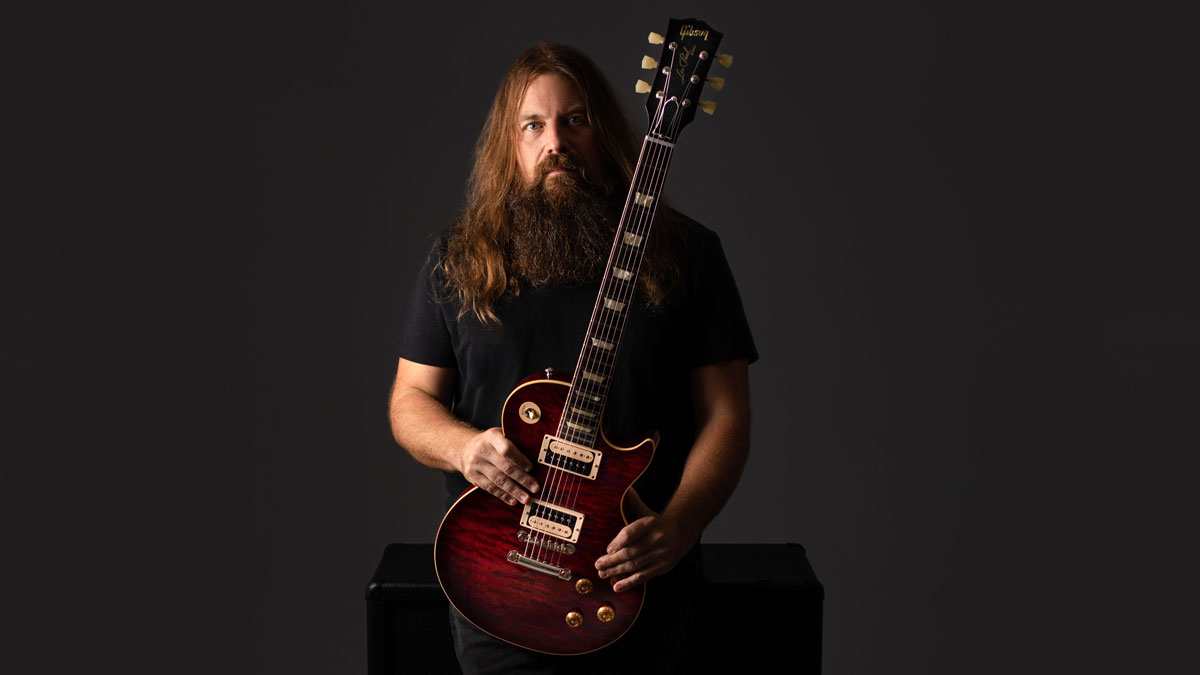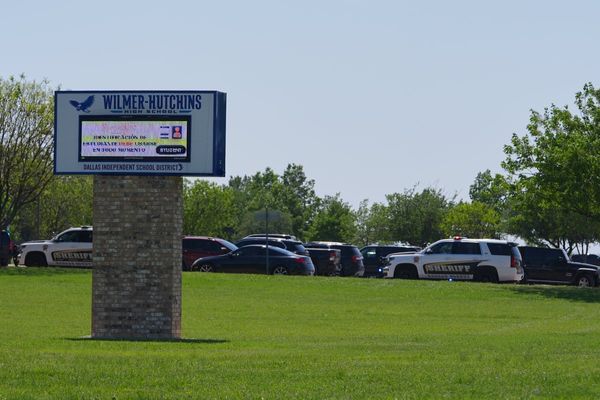
In September 2022, Gibson’s social media accounts shared the news of yet another high-profile endorsee joining ranks. Business as usual, then, were it not for this particular guitarist’s longstanding relationship with Jackson – a partnership that spawned a whole line of Dominion signature models. The artist in question, of course, was Lamb of God co-founder Mark Morton – whose guitar work over the last two decades has shaped the sound of modern metal and inspired waves of new bands in the process.
But when we put it to him that the news came as a bit of a shock, given that he’d been wielding Jackson guitars pretty for the entirety of his band’s career, he explained how switching over to Gibson felt very much like coming home...
“The thing is Gibson was always there for me,” he shrugs, connecting with Guitar World while on vacation in the picturesque Outer Banks of North Carolina. “The first guitar that I really fell in love with was a Les Paul and I still have it. I wouldn’t say it’s a particularly valuable or sought-after Gibson, but I’ve posted about it on my Instagram and it’s a 1975 Deluxe that was hacked up for humbuckers, because obviously it was originally made for mini humbuckers...
“Somebody hacked it up before I got it, almost like they’d used a chisel or hammer! It was a husk when I got it and I had it all put back together. That’s the guitar I played in Burn the Priest and before. I’d had other Les Pauls too, but that particular Norlin is the one that stuck with me. It was the guitar I first really bonded with.”
That’s not to say that the guitarist looks back on his last two decades with Jackson in any negative light whatsoever. He has nothing but wonderful memories of working with the company, and holds the various personnel he worked with there in high esteem.
Though he’s very appreciative of all the newfound support over at Gibson, he’s keen to point out “that doesn’t mean anything was lacking at Jackson”. Perhaps most tellingly of all, a closer look into the spec of his now discontinued signature models reveals a lot about where the inspiration came from and what he was trying to achieve...
“I’m super-proud of the guitars we made,” he continues. “I still have quite a few of them, obviously. But a lot of the specs, particularly the handmade ones I was playing, were based on that ’75 Les Paul. It was the same kind of slim neck. In fact, when we spec’d out the Dominion, we went fret-by-fret and measured my Les Paul, using it as the platform for the whole design.
“And then of course you’ve got the dual volumes and tones, the pickup selector on the top horn and two humbuckers… it was basically a neck-thru Les Paul! So this whole idea of it being shocking that I’d moved to Les Pauls was kinda funny because to me that’s kinda what I was playing already! Okay, there were a few differences like the scale length, but it was very close. I didn’t realize how diehard the Jackson community was until I switched! Honestly, going to Gibson felt very full circle because that’s where I started.”

So we’d be right in guessing a Mark Morton signature range through Gibson is currently in the works?
“What I can tell you definitively is that Gibson have been incredibly supportive and very open to ideas that I have… and I have a lot of them. It’s a wonderful community full of very creative people who are great listeners.”
Well, that’s an exclusive, then – the debut Mark Morton signature Les Paul Custom will be arriving next March…
“Hey, if you’ve got inside information, you let me know [laughs]!”
Seriously though, given what Gibson have been doing with the likes of Kirk Hammett, Dave Mustaine, Adam Jones and Richie Faulkner, it must feel like you’re in good company.
“Yeah! And I ended up jamming with Richie not long ago. I was in Nashville working on some music stuff and [recently appointed Gibson CEO] Cesar Gueikian invited me to his house. I think he does pizza every Sunday night or something. I went over and Richie was there, along with a few other folks.
“After dinner, we went upstairs to his jam room. And Cesar’s just handing out these legendary guitars, like ‘Oh yeah, here’s [1959 Les Paul Standard] Gemini or play [1959 Black Beauty] The White Whale and all these crazy guitars. Me and Richie were jamming out and improvising, grabbing the most ridiculous guitars. Richie is a great player and a sweet dude. His new Flying V looks awesome!”
You’ve become a bit of a collector over the last few years. Let’s go through your favorites, starting with the one you’re most attached to...
“I’d say the biggest one in the collection, the Holy Grail for me, would be my early-1960 Les Paul Custom three-pickup Black Beauty. It’s a 00 serial, which signifies it being an early ’60 with 1959 appointments. When you start collecting vintage stuff, you start using terms like that to help you understand what you’re dealing with. So it’s a ’59 spec 1960 with three pickups… one too many for me!
“Sometimes older Customs can be a little flat and weigh heavier than the Standards, but this one is a really remarkable instrument. It’s very resonant in a way that really sings and sustains. It has those beautiful grainy PAF tones and breaks up so nicely.
“It’s pretty pristine too, given its age. It has been played but it’s been well taken care of. I’m thrilled to be its caretaker. I got it earlier this year, so I haven’t had it long. I really only started collecting guitars like this about a year ago. This one was bought privately…”
So what comes next in terms of monetary or personal value?
There’s something magical about that era of making guitars, from the process to the wood
“I have a really phenomenal 1960 Fender Stratocaster that I love. This and the 1960 Black Beauty are probably the guitars I’m playing the most right now. It’s just a really great Strat… there’s something about old guitars that you can’t quite put your finger on.
“I saw an interview with Jason Isbell, who has got one hell of a collection, where he was talking about his vintage stuff. I’m misquoting him but he basically said there was this 10 percent tone and feel difference that you can’t quite attain, even through the greatest replicas and painstakingly handmade renditions of classic stuff. There’s a layer that just can’t quite be copied. There’s something magical about that era of making guitars, from the process to the wood.”
What does the 1960 Strat look and sound like?
“It’s a sunburst, which is interesting because if it was in a custom color like Fiesta Red or Olympic White it would be worth double in value… and they’re already pretty expensive guitars as it is! It’s all original with the case, the three-way pickup selector, the mint green pickguard and it has this really sparkly sound that’s not as tinny and high-pitched as what most people expect from a Strat.
“It breaks up really nicely. In 1959 and the early ’60s, they had a thick slab of rosewood as the fretboard. That’s what I like, at least. A lot of Strat people think of the 1957 ones as the Holy Grail, with the V-neck and maple fretboard. I prefer the softer and warmer sound of rosewood. For some reason, 1960 seems to be the sweet spot for me in general!”
There’s also a lovely 1969 Black Beauty that’s made a few appearances on your Instagram account....
“Yeah, it’s a very early 1969 Les Paul Custom Black Beauty, to the point where it’s ’68 build. I actually got the shipping logs from Kalamazoo back then and found my serial number on there. This guitar was shipped out of the factory on January 17, 1969… which is basically a 1968, with all the appointments of that year like the one-piece neck, the dotted ‘i’ logo and all these other geeky details to help us figure out when it was made.
“It’s another really clean guitar. It has really flat frets because back then these guitars were called Fretless Wonders. My 1960 Custom is similar, though it has ever so slightly higher frets. None of my stuff has been refretted. The 1968 has been played more too, so the little bit of fret it had has been worn down. It’s a very cool guitar, with the patent stick pickups and witch hat knobs and all that cool stuff.
“Those ’68s and early ’69s are celebrated because the theory is they were using some of the blanks from what would have been from 1959 and 1960. The idea is that they were using up all that old wood, which is a good thing! Then later in 1969 they started pancaking the bodies.”
We obviously have to touch on your Les Paul Standard Goldtop from the same year...
“That Goldtop was made around March or April, which is a bit like a partner to the Custom. It has P-90s and it’s such a fun guitar to play, with taller frets and that really barky classic rock sound. The Les Paul, in its original form, disappeared in 1960 and they started making SGs and calling them Les Pauls.
“Then, back by popular demand, the Les Paul came back at the end of 1968 in two forms – one being a Black Beauty with humbuckers and a Goldtop with P-90s. The gold finish checks up really cool, with some interesting color changes on it, so it’s just as spectacular aesthetically.”
How do you go about making sure you’re getting a good deal when buying vintage guitars?
“Well, there’s collector-grade stuff and then player-grade stuff. Some guitars might be worth a lot of money as collector models, but are they really going to sound any better? If you’re reading this and not that dialed into vintage stuff, don’t make the mistake of thinking if something is old or from a certain year it will be the best guitar you’ve ever played. Sometimes they are! I’ve played a number of 1959 Les Pauls and a few of them were the best guitars I’ve ever played. And a few of them weren’t… they were just cool.
“There’s the collector lens and the player lens. Everyone has their own approach but I try to have my own Venn diagram of an instrument’s worth. Ultimately, it has to be something I want to play. It helps if it’s really collectable and will appreciate in value. Sure, they’re good talking points, but I want to play and hear these guitars first and foremost. That early 1969 Custom is a great guitar…”
Would you ever consider getting it refretted?
“Given the way I play and what I play, which is mainly blues and metal, it can get a little tricky with those flatter frets. In an ideal world, I’d have more fret on that guitar but it’s so clean and such a preserved example that I don’t want to refret it. I have some really knowledgeable people, like Cesar, who have said just go ahead and do it. But I just don’t want to… it’s too pretty!”
One of your most recent purchases was a 1964 SG Junior, but you’ve also got some ’50s Juniors in the collection, too...
in terms of tone versus dollars, you can’t beat a Junior
“I have a 1956 singlecut and a 1959 doublecut, both with single P-90s. I think they’re great guitars, even though they were brought out in the ’50s as student guitars with little button tuners and one volume and tone for its single pickup on a slab of mahogany. It’s such a simple design that Gibson initially intended to be people’s first guitars when they were 14 or 15 or whatever.
“But then people like Leslie West started playing them, and more modern guitarists like Billie Joe Armstrong and Charlie Starr. I think Johnny Thunders and Joan Jett played them too, so a lot of rock history has come out of those Juniors. I feel like they offer the most value for money and even though an old ’50s or ’60s model will still be quite expensive, they are way more affordable than some of these other guitars we’re talking about.
“So in terms of tone versus dollars, you can’t beat a Junior. You still get that old wood and all the magic of a golden-era Gibson, but the vintage ones are closer to the price of a high-end new guitar instead of something that costs the same as a really nice car or house!”
Do you think you’ll ever be adding a 1959 Burst to the collection?
“The 1959 Les Paul Standard is probably the most sought-after, prized and top of the pedestal guitar there is [laughs]. I don’t have one of those Bursts! Joe Bonamassa and Slash have a few between them. Kirk might be catching up, too! But who knows… I was talking to Charlie Starr from Blackberry Smoke just the other day, who also has a love for older guitars, saying, ‘Hey, if we don’t collect these guitars, who will?!’ We’re both just fulfilling our destinies.”
Let’s talk about Les Paul weights for a second. Bearing in mind the Customs played by guitarists like Adam Jones will probably be heavier than the Standards used by the likes of Joe Bonamassa, what seems to work best for you?
Nowadays some people seem to think the lighter guitars will be more resonant and sing. For me, I think once you get past 10 pounds for a Custom, that’s a bit too heavy
“You’re right to point out that you should expect different things from those different models. In my experience, I would say Customs are typically heavier for whatever reason. It also depends on the year. Like you said with Adam Jones’ Silverburst, there was a philosophy in the late ’70s that heavier guitars sounded better.
“Nowadays some people seem to think the lighter guitars will be more resonant and sing. For me, I think once you get past 10 pounds for a Custom, that’s a bit too heavy. But I don’t expect a Custom to weigh less than nine – in fact, a nine-pound Custom is pretty light...
“So there’s a window for me. I’ve seen quite a lot that are over 10. I’m 50 years old and my back isn’t what it used to be. That extra pound or whatever is definitely noticeable! On a Standard, I like them to be in between eight-and-a-half and nine-and-a-half. Eight is great, too, but I really haven’t played many vintage Standards that light… Joe Bonamassa must be sweeping them all up.”
It definitely feels like attitudes are changing towards Norlin-era Gibsons and things like T-Top pickups...
“People have really come around to Patent Sticker and T-Top pickups. Before it would be like, ‘Oh, too bad it’s not a PAF,’ but now people are selling them on Reverb for crazy money. Guitar players have learned over time to appreciate things like that because they do actually sound great. PAFs are the benchmark, right?
“But with all the stuff we’re using in between that pickup and the speaker, we can account for the differences and make changes. All of these things are different components of our tone. There are so many incremental steps along the way that influence where you land. We have options! We can make a T-Top sound like a PAF or vice-versa, just by sticking a Klon into the mix or trying a different amp.”
Speaking of which, you posted about recently buying your first Klon from a guy in a carpark with a shopping bag. It all sounded ever so slightly... illicit?!
“That’s what it felt like [laughs]! I was on a little trip with my lady, staying at this beautiful hotel and going to see all the cool stuff in the local museums. And then I got a text from a buddy of mine who was like, ‘You wanna buy this Klon?’ and the answer was, ‘Hell yeah, I do!’
“Because I’d be looking for one and almost bought one or two, but now it was coming from a guy I knew and who I trusted. So I said to my lady, ‘Uh, I’m gonna go meet this dude and buy a pedal – I’ll be about 30 minutes!’ and went over [laughs].”
So what’s the verdict, then?
“I love it! I’ve gone through a bunch of klones and some of them are really good. I would actually say some of the best ones out there sound very close and just as great. But the collector side of me wants the real one, which there was only a limited production of. And it just sounds awesome.”
Lamb of God will be hitting the road with Pantera soon. That must be incredibly exciting, given how much influence they’ve had on your music...
“I haven’t seen this reunion live yet, only clips online. I will certainly be watching when we get out there. I’m excited to be part of it and I think it’s great for the fans. I had the opportunity to see Pantera live when I was younger. It was very special then.
“They had a huge influence on me, to the point where I would say Lamb of God wouldn’t have existed without Dime and Vinnie. They were such a huge influence on several of us, though maybe not all of us. To be along for this celebration and tribute means a lot.”
Given how close they were, it makes perfect sense it’s Zakk Wylde up there in Dimebag’s spot...
“Honestly, Zakk is the only guy to play those songs in this context. I can’t say he’s taking that spot… because nobody can. Zakk is a monster guitarist and another huge influence on me. But nobody fills those shoes, not even Zakk. I imagine he would say exactly the same thing. He’s playing those songs very well and I think he’s the only person who could do them justice like that.
“As you mentioned, he was closely connected to Dime and Pantera from back in the day and the same goes for Charlie [Benante, drums] too. Respect to everyone that put it together this way because it’s the only way it would have worked, in my opinion… and my opinion doesn’t matter. All that matters is that it’s great for the fans. That’s the biggest plus – all of the people getting to see those songs live and celebrate the music.”
- Lamb of God are currently on tour with Pantera across the United States – see Pantera.com for full dates.







